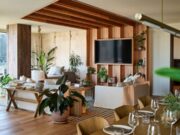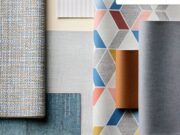Green Design
Home Green Design
 With the goal of reducing energy costs and minimizing environmental impact, architects and designers are getting serious about green design. Every part of the property can be impacted and savvy designers are incorporating reclaimed materials and restorative greenery. Visit Green Lodging News for the latest news and best practices. Got news or a story idea to share? Contact Glenn Hasek, editor, at (813) 510-3868, or by e-mail at: greenlodgingnews@gmail.com.
With the goal of reducing energy costs and minimizing environmental impact, architects and designers are getting serious about green design. Every part of the property can be impacted and savvy designers are incorporating reclaimed materials and restorative greenery. Visit Green Lodging News for the latest news and best practices. Got news or a story idea to share? Contact Glenn Hasek, editor, at (813) 510-3868, or by e-mail at: greenlodgingnews@gmail.com. 1 Hotel Melbourne is Now Open
MELBOURNE, AUSTRALIA—1 Hotels, the mission-driven luxury lifestyle brand founded by hospitality visionary Barry Sternlicht, announces the official opening of 1 Hotel Melbourne. This nature-inspired property marks the brand’s long-anticipated debut in Australia, redefining the future of luxury hospitality in the heart of one of the world’s most forward-thinking cities.
Developed in partnership with Melbourne-based Riverlee, the hotel is set along 220 meters of uninterrupted Yarra River frontage in the revitalized North Wharf precinct. The building is a celebration of Melbourne’s storied past and a blueprint for a more sustainable future, brought to life through biophilic design principles and a commitment to living in harmony with nature. The...
Introducing Hyphyn: The First Biodegradable Performance Vinyl
NEW YORK—Hyphyn, the first biodegradable performance vinyl, introduces a breakthrough in sustainable materials, proving that high performance and environmental responsibility can coexist. Engineered with a patented enzyme system and proprietary resin formulation, Hyphyn delivers commercial-grade durability while biodegrading over 90 percent within two years in landfill conditions—a first for performance vinyl.
“True innovation isn’t just about creating something new—it’s about rethinking what’s possible,” says Iwan Nassimi, Executive Vice President of Nassimi, makers of Hyphyn. “Hyphyn reimagines vinyl’s lifecycle, offering the performance the industry relies on while solving the long-term environmental impact challenges no other vinyl has addressed.”
Redefining Sustainable Performance
Traditional vinyl...
Marriott’s Danielle Khoo: Helping to Smooth the Path to Smart Design, Environmental Efficiency
Name: Danielle Khoo
Title: Director of Sustainability | Global Design Strategies
Company: Marriott International, Inc.
Years in Current Position: Two years and three months.
Primary Responsibilities: “Lead the sustainability strategy within the design and development processes with a focus on the built environment.”
Company’s most significant accomplishment in design sustainability: “We released updates to new-build standards. It was quite the undertaking to update the standards.”
Company’s most significant challenge moving forward in sustainability: “Minimizing our environmental impact while continuing to grow. Hotel companies are measured by growth. Getting over that hurdle.”
SEATTLE—As Director of Sustainability | Global Design Strategies for Marriott International, Danielle Khoo ensures that...
Tarkett Innovates Circular Recycling Solution for Powerbond Hybrid Carpet
SOLON, OHIO—On its path toward circularity, global flooring manufacturer Tarkett has found a new, circular solution for its renowned Powerbond hybrid carpet. Leveraging the power of mushrooms, now any Powerbond returned to Tarkett’s ReStart take-back and recycling program will be transformed into biobased raw materials for use in future Tarkett Sports products being introduced in the coming months.
“Recognized for its unmatched durability and performance, Powerbond has been a cornerstone of Tarkett’s innovation portfolio for decades. Reclaiming it after years—sometimes decades—of use and converting it into a biobased raw material isn’t just progress, it’s a breakthrough,” said Roxane Spears, Vice President of Sustainability. “This...
Announcing the 2025 Best of NeoCon Winners
CHICAGO—The 35th annual Best of NeoCon Awards kicked off NeoCon 2025 this week with a high-energy ceremony at THE MART, spotlighting the most forward-thinking products transforming the future of commercial interiors. A cornerstone of NeoCon since 1990, the iconic program celebrates exceptional solutions spanning workplace, healthcare, education, retail, and hospitality. This year, 96 awards were given to exhibitors for products across more than 40 categories, with honors awarded for Gold, Silver, Innovation, Sustainability, and Business Impact. The program’s top distinction, Best of Competition, was awarded to Halcon for its Astoria collection of conference and mobile communal tables.
A multidisciplinary jury of 42 architects,...
PM Hotel Group Further Expands Its Lifestyle Division, Modus by PM Hotel Group
CHEVY CHASE, MD.—PM Hotel Group has experienced continued strategic growth across its overall portfolio, including its lifestyle and unconventional hospitality division Modus by PM Hotel Group. With a focus on authentic and immersive destinations, the company has significantly expanded its presence in key markets, targeting today’s independent-minded travelers seeking hotel stays that connect people and place.
“At PM Hotel Group, we’re not just growing our portfolio—we’re carving out a unique space in the lifestyle segment through our Modus by PM Hotel Group division by developing and operating properties that deliver bold and authentic hospitality experiences,” said Paul Sacco, Chief Growth...
Interface Introduces Global Carpet Tile & LVT Collections
ATLANTA—Interface, Inc., the global flooring solutions company and leader in sustainability, launched the Dressed Lines carpet tile and Lasting Impressions luxury vinyl tile (LVT) global collections. Both collections lean into the company’s legacy of smart design, creating a complete design experience and bringing a modern lens to design classics with innovative patterns, constructions, and manufacturing processes.
The Dressed Lines carpet tile collection is inspired by post-war modernism, reflected in its playful use of contrast and angular shapes. Lasting Impressions LVT offers a different take on timeless visuals, drawing on the traditional crafts of tatami and plaster artisans. These collections feature...
The Good Plastic Company to Debut New Growth Collection at NeoCon
CHICAGO—NeoCon 2025 marks a momentous step for The Good Plastic Company’s trajectory in the North American market. Exhibiting for the first time at THE MART (booth #7-3053), the leading sustainable materials manufacturer will debut new and notable developments across its signature Polygood line—highlighting the Growth collection, newly earned Declare Label certification, and a collaboration with ergonomic innovator Humanscale at Fulton Market.
Rooted in circular design, technical performance, and visual impact, the company’s NeoCon presence underscores the expanding role of sustainable materials in the future of commercial interiors and contract furniture. “NeoCon represents a pivotal moment for us—it shows how much we’ve grown in North America and highlights the...
Bradley’s Elvari Washroom Accessories Collection Wins Design Award
MENOMONEE FALLS, WIS.—Bradley Co. announced that its expansive Elvari Washroom Accessories Collection has been named a winner of the 2025 IIDA/HD Expo Product Design Awards in the category of Bath/Spa—Equipment, Whirlpool/Saunas, Fitness, and Wellness. This distinguished recognition celebrates products that excel in aesthetics, design innovation, environmental responsibility, and technical advancements, setting the benchmark for excellence in hospitality design.
The annual IIDA/HD Expo Product Design Awards, presented by the International Interior Design Association (IIDA) and Hospitality Design (HD) magazine, spotlights industry leaders pushing the boundaries of innovation and guest experience. This year’s winners were selected by an esteemed panel of design professionals who evaluated entries based...
Tarkett Showroom Celebrates Resonant Spaces During Design Days
SOLON, OHIO—Global flooring manufacturer Tarkett will open its Chicago showroom doors (215 N. Peoria Street, Floor 10) to design professionals from around the world during Design Days, June 9 to 11. Attendees to the commercial interior design event will get an exclusive look at Tarkett’s newest initiatives and product collections, including its most anticipated workplace carpet tile collection of the year, Resonant Spaces.
Inspired by the invisible threads that tie together people, space and energy, Resonant Spaces provides the foundation for comfortable interiors that support heightened creativity, deepened focus and lifted spirits. The collection features three harmonious patterns in nine...








